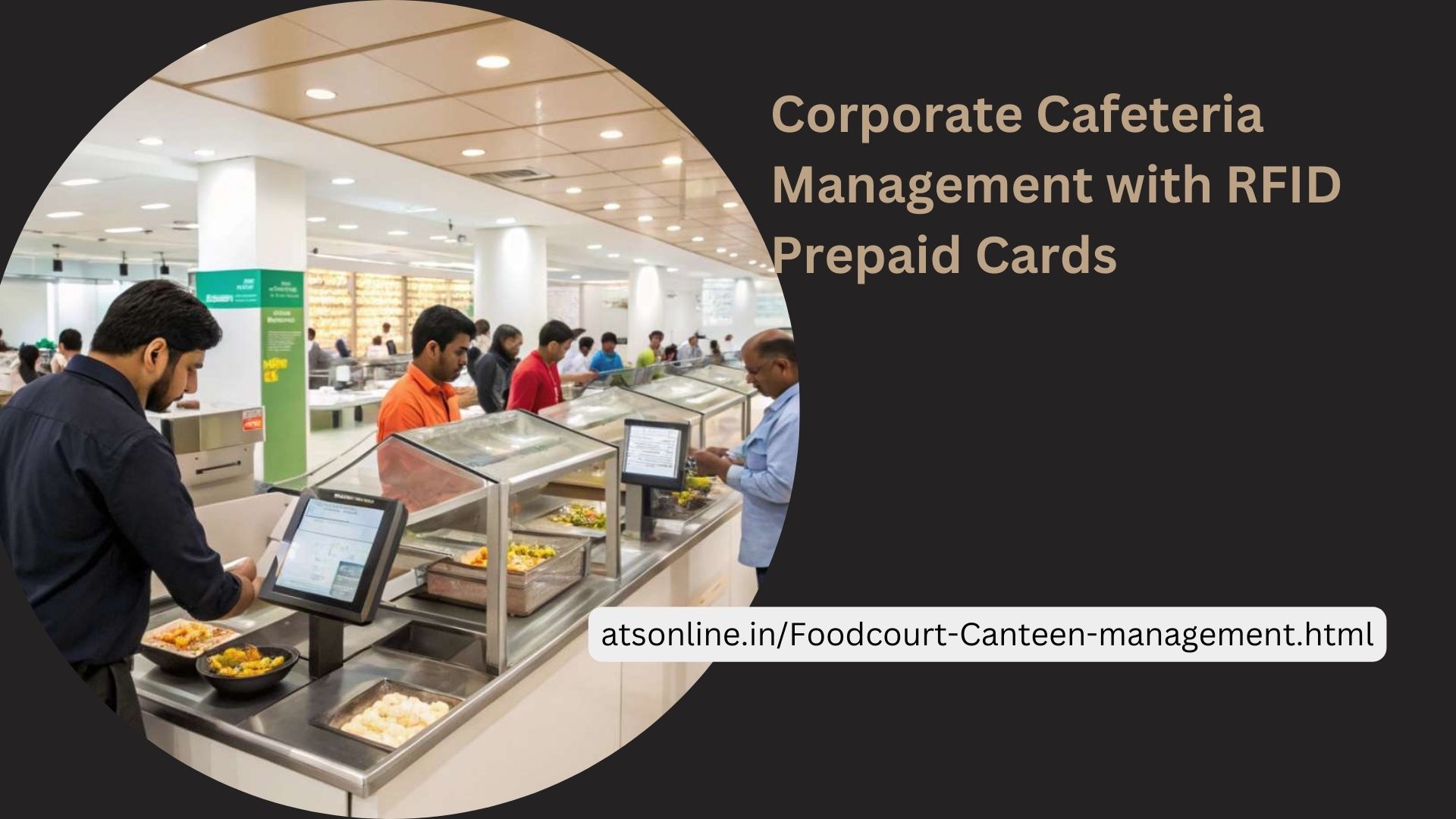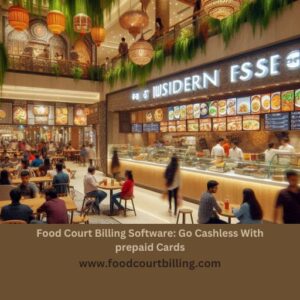Streamline your corporate cafeteria management, reduce queues, and boost employee satisfaction with RFID prepaid card systems. Learn how to implement and benefit from this technology.
The Challenges of Traditional Corporate Cafeteria Management in India
For many companies in India, the daily lunch rush in the corporate cafeteria presents a recurring set of challenges. Traditional cafeteria management methods, often reliant on cash transactions and manual processes, can lead to a number of frustrating inefficiencies for both employees and the cafeteria staff. These issues not only impact employee satisfaction but can also affect overall productivity and operational costs. Let’s examine some of the most common pain points:
- Long Queues and Wait Times: This is arguably the most visible problem. During peak hours, employees often face lengthy queues, wasting valuable time waiting to order and pay for their meals. This can be especially problematic for employees with limited lunch breaks. This issue directly impacts queue management, a core component of efficient cafeteria operations.
- Cash Handling Issues: Relying on cash transactions introduces several complications:
- Hygiene: Handling cash, especially in a food service environment, raises hygiene concerns. This is particularly relevant in today’s health-conscious world.
- Theft and Reconciliation: Cash handling increases the risk of theft, both internal and external. It also makes accurate accounting and reconciliation more complex and time-consuming.
- Inconvenience: Employees may not always have the exact change, leading to delays and further extending queues.
- Difficulty Tracking Employee Meal Allowances and Subsidies: Many companies offer meal allowances or subsidies to their employees. Managing these benefits manually, through paper vouchers or spreadsheets, is prone to errors and can be difficult to track effectively. This makes it hard to ensure fair and consistent application of employee meal programs and staff meal benefits.
- Limited Data for Menu Planning and Inventory Management: Traditional methods often lack the ability to gather detailed data on meal preferences, popular items, and peak consumption times. This makes it difficult to optimize menu planning, leading to potential food waste and inefficient inventory management. Without accurate data, cafeterias may struggle to meet employee demand and minimize costs.
- Manual Processes Leading to Inefficiencies: Many aspects of traditional cafeteria management, from order taking to payment processing to accounting, involve manual processes. This not only increases the workload for cafeteria staff but also increases the likelihood of human error. The lack of automated processes hinders streamlined operations.
- Lack of Payment Options: Limiting payment to cash can be inconvenient for employees who prefer electronic payment methods. While digital wallets are gaining popularity, a dedicated, integrated system is often more efficient.
But what if there was a way to eliminate these headaches and create a smoother, more efficient, and more satisfying workplace dining experience? Enter RFID prepaid cards – a key component of modern corporate cafeteria management systems. These cards offer a simple, yet powerful solution to many of the challenges faced by traditional cafeterias.
Are you struggling to reduce long lines in your corporate cafeteria? Solutions like those offered by Advance Technology Systems are transforming office canteens in India, providing a streamlined and efficient approach to food service management. By embracing technology, companies can create a more positive and productive environment for their employees. The implementation of RFID prepaid cards represents a significant step towards improved corporate dining solutions.
What are RFID Prepaid Cards?
RFID, or Radio-Frequency Identification, is a technology that uses electromagnetic fields to automatically identify and track tags attached to objects. In the context of a corporate cafeteria, these tags are embedded in prepaid cards, often resembling standard employee ID cards. Think of it as a more advanced, contactless version of a barcode. Unlike barcodes, which require a direct line of sight to be scanned, RFID tags can be read from a short distance, even if they’re not directly visible. This is what enables the “tap-to-pay” functionality that makes RFID so efficient.
How it Works in a Corporate Cafeteria:
The implementation of an RFID prepaid card system in a corporate cafeteria typically involves the following steps:
- Card Issuance: Each employee receives an RFID prepaid card. This card can be a dedicated cafeteria card or, even better, integrated into their existing employee ID card, streamlining access control and meal payments into a single card.
- Top-Up Methods: Employees can add funds to their cards through various convenient methods:
- Kiosk: Self-service kiosks located within the cafeteria or other convenient locations allow employees to top up using cash or cards.
- Payroll Integration: The most seamless option is to integrate the system with the company’s payroll, allowing for automatic deductions or additions to the card balance based on pre-defined rules (e.g., daily/weekly meal allowances).
- Tap-to-Pay: At the point of sale (POS) in the cafeteria, employees simply tap their RFID card on a card reader. The system instantly deducts the appropriate amount from their card balance. This eliminates the need for cash handling and significantly speeds up the transaction process. The use of NFC Technology (Near-Field Communication), a subset of RFID, is often employed for this contactless payment.
Types of Cards:
While the basic functionality remains the same, there can be variations in the types of cards used:
- Dedicated Cafeteria Cards: These cards are solely used for cafeteria payments.
- Integrated Employee ID Cards: These cards combine employee identification, access control (e.g., building entry), and cafeteria payment functionality into a single card. This offers greater convenience and reduces the number of cards employees need to carry.
Security Features:
RFID prepaid card systems incorporate several security features to protect against fraud and unauthorized use:
- Unique Identifiers: Each card has a unique identifier, preventing duplication or cloning.
- Transaction Limits: Spending limits can be set on the cards to minimize potential losses in case of theft or loss.
- Tamper Proof technology.
Benefits of RFID Prepaid Cards for Corporate Cafeteria Management
Implementing an RFID prepaid card system offers a wide range of benefits for both the company and its employees, transforming the entire cafeteria experience. These advantages address many of the pain points associated with traditional cafeteria management.
Faster Transactions & Reduced Queues (“Reduce Long Lines in Corporate Cafeteria with RFID”)
This is perhaps the most immediate and noticeable benefit. The tap-to-pay functionality of RFID cards dramatically speeds up transaction times compared to cash or even traditional card payments. Employees no longer need to fumble for change or wait for card authorization. This can reduce transaction times by up to 70%, leading to significantly shorter queues and reduced wait times during peak hours. This directly translates to increased employee satisfaction and allows them to spend more time enjoying their meals and less time waiting in line. This addresses the core need for improved queue management.
Cashless Transactions & Improved Hygiene (“Improve Hygiene in Office Canteens with Contactless Payments”)
Eliminating cash handling brings significant hygiene benefits, especially crucial in a food service environment. Cashless cafeteria solutions minimize the spread of germs and bacteria, creating a healthier and safer environment for employees. This is particularly important in the post-pandemic world, where hygiene awareness is heightened.
Streamlined Employee Meal Allowances & Subsidies (“Manage Employee Meal Allowances with RFID”)
RFID systems make it incredibly easy to manage and track employee meal allowances and subsidies. Companies can automate these programs, setting daily, weekly, or monthly limits for each employee. The system automatically deducts the appropriate amount from the employee’s card balance, ensuring that allowances are used correctly and consistently. This eliminates the need for manual tracking and reduces administrative overhead. This automation helps automate meal subsidy programs efficiently.
Enhanced Data Collection & Reporting (“Data Analytics,” “Reporting & Insights”)
One of the most powerful advantages of RFID systems is their ability to collect valuable data. Every transaction is recorded, providing detailed insights into:
- Meal Preferences: Which menu items are most popular?
- Peak Hours: When is the cafeteria busiest?
- Employee Spending Habits: How much are employees spending on average?
- Inventory Levels: Which items need to be reordered?
This data can be used to generate comprehensive reports, enabling data-driven decision-making. Cafeteria managers can optimize menu planning to reduce food waste, improve inventory management to ensure adequate stock levels, and tailor offerings to better meet employee demand. The ability to obtain “real-time data on cafeteria sales and inventory” is a game-changer.
Improved Employee Satisfaction (“Employee Satisfaction”)
Faster service, convenient payment options, and personalized benefits all contribute to a more positive cafeteria experience. Employees appreciate the efficiency and convenience of RFID cards, leading to increased satisfaction and potentially boosting morale. “How to improve the Corporate Cafeteria Experience” is a question directly answered by the enhanced convenience and speed offered by RFID systems.
Simplified Accounting & Reconciliation (“Streamlined Operations”)
RFID systems automate transaction tracking and reporting, significantly simplifying accounting and reconciliation processes. This reduces manual accounting tasks, minimizes errors, and frees up cafeteria staff to focus on other important tasks.
Integration with Existing Systems (“Integrate Cafeteria Management with [ATS product/service],” “Integrate RFID with existing payroll systems”)
A key advantage of many modern RFID cafeteria solutions is their ability to integrate with existing company systems, such as payroll, HR, and accounting software. This integration streamlines data flow, eliminates data silos, and further automates processes. For example, meal allowances can be automatically deducted from payroll, simplifying administration and ensuring accuracy. This seamless integration is a major selling point for companies looking for a comprehensive solution.
Implementing an RFID Prepaid Card System: A Step-by-Step Guide (“How to Implement RFID Prepaid Cards in a Corporate Cafeteria”)
Implementing an RFID prepaid card system requires careful planning and execution. Here’s a step-by-step guide to ensure a smooth and successful transition:
Needs Assessment
Before making any decisions, it’s crucial to conduct a thorough needs assessment. This involves analyzing your current cafeteria operations and identifying your specific requirements. Consider the following:
- Number of Employees: How many employees will be using the system?
- Peak Hours: What are your busiest times? This will help determine the number of POS terminals needed.
- Current Transaction Volume: How many transactions do you process daily?
- Existing Infrastructure: What systems (payroll, HR, accounting) do you currently have in place?
- Budget: What is your budget for the implementation and ongoing maintenance?
Choosing a Provider (like Advance Technology Systems)
Selecting the right provider is critical for the success of your implementation. Research different vendors and compare their offerings. Consider the following factors:
- Experience and Expertise: Look for a provider with a proven track record in implementing RFID cafeteria solutions.
- System Features: Ensure the system meets your specific needs and offers the features you identified in your needs assessment.
- Scalability: Choose a system that can scale to accommodate future growth.
- Customization Options: Can the system be customized to meet your specific requirements?
- Customer Support: What level of support does the provider offer?
- Pricing: Compare pricing models and ensure they fit your budget.e.
System Setup & Installation (“Steps to set up RFID Cafeteria Systems”)
The system setup and installation typically involve the following:
- Hardware Installation: This includes installing card readers at each POS terminal, setting up self-service kiosks (if applicable), and configuring the network infrastructure.
- Software Installation: The provider will install the necessary software on your servers or provide a cloud-based solution.
- System Configuration: The system will be configured to meet your specific requirements, including setting up meal allowances, pricing, and reporting parameters.
- Testing: Thorough testing is crucial to ensure the system is working correctly before going live.
Card Issuance & Top-Up Methods
Once the system is set up, you’ll need to issue RFID cards to your employees. This may involve:
- Card Printing: If you’re using dedicated cafeteria cards, you’ll need to print them with employee information and the RFID chip.
- Card Integration: If you’re integrating the RFID functionality into existing employee ID cards, you’ll need to work with your ID card provider.
- Employee Communication: Clearly communicate to employees how to obtain their cards, how to use them, and how to top them up. Provide clear instructions on the different top-up options (online portal, kiosk, payroll deduction), emphasizing the convenience of the employee meal card management system.
Addressing Common Concerns
Implementing a new system often raises questions and concerns. Here are some common concerns about RFID cafeteria systems, addressed directly:
What if an employee loses their card?
This is a valid concern, but RFID systems have built-in mechanisms to handle lost or stolen cards. The process typically involves:
- Reporting: The employee reports the lost or stolen card to the cafeteria management or HR department.
- Card Blocking: The lost card is immediately blocked in the system, preventing any unauthorized use.
- Replacement Card: A replacement card is issued to the employee, usually with the remaining balance transferred from the lost card.
The key is to have a clear and well-communicated process for reporting lost cards. Security measures, such as transaction limits, also minimize potential losses.
Is it expensive to implement? (“How Much Does an RFID Cafeteria System Cost?”)
The cost of implementing an RFID cafeteria system varies depending on several factors, including the size of your organization, the number of POS terminals required, the features you choose, and the provider you select. There’s an initial investment in hardware (card readers, kiosks, etc.) and software, as well as ongoing costs for maintenance, support, and potentially transaction fees.
However, it’s crucial to consider the long-term return on investment (ROI). RFID systems can lead to significant cost savings through:
- Reduced Labor Costs: Automated processes reduce the need for manual cash handling and accounting.
- Improved Efficiency: Faster transaction times reduce queues and improve overall efficiency.
- Reduced Food Waste: Data-driven insights help optimize menu planning and reduce food waste.
- Minimized Theft and Errors: Cashless transactions reduce the risk of theft and accounting errors.
The long-term benefits often outweigh the initial investment.
What if the system goes down?
System downtime is a valid concern. Reputable providers have contingency plans in place to minimize disruptions:
- Backup Systems: Redundant systems and backup power sources can ensure continued operation in case of a power outage or network failure.
- Offline Transaction Capabilities: Some systems allow for limited offline transaction processing, enabling employees to continue making purchases even if the network is temporarily unavailable. The transactions are then synchronized with the main system once the connection is restored.
Case Studies: Real-World Examples of Success in India
While specific company names might be confidential, we can describe typical success scenarios:
- Large IT Company in Bangalore: Implemented an RFID system for their 5,000+ employees. Reduced average queue times by 60%, increased employee satisfaction, and saw a 15% reduction in food waste due to improved data analysis.
- Manufacturing Facility in Chennai: Integrated RFID with their existing employee ID cards. Streamlined access control and cafeteria payments, improving operational efficiency by 10%.
- Financial Services Firm in Mumbai: Implemented a cashless cafeteria system with online top-up options. Saw a significant increase in employee participation in the meal program due to the added convenience.
These examples demonstrate the tangible benefits of RFID systems in various corporate settings in India. Quantifiable results (percentages, figures) make the case studies more compelling.
Integration with Wellness
Cafeteria systems are increasingly being integrated with corporate wellness programs, providing employees with nutritional information and encouraging healthy eating habits.
Conclusion: Transform Your Cafeteria Today
RFID prepaid cards offer a powerful solution for modernizing corporate cafeteria management. They address the challenges of traditional systems, providing numerous benefits for both companies and employees. From reducing queues and improving hygiene to streamlining operations and providing valuable data insights, RFID technology is transforming the workplace dining experience.
Ready to revolutionize your corporate cafeteria management?
Contact Advance Technology Systems today to learn more about our RFID prepaid card solutions and cafeteria management systems. Visit www.atsonline.in to explore our offerings and discover how we can help you create a more efficient, convenient, and satisfying cafeteria experience for your employees. Take the first step towards a more modern and efficient office canteen – your employees will thank you!
FAQs:
1. Question: How do RFID cards speed up corporate cafeteria lines?
Answer: RFID cards use contactless tap-to-pay technology, eliminating cash handling and manual card processing. This drastically reduces transaction times, leading to shorter lines and faster service.
2. Question: Can RFID systems track employee meal allowances easily?
Answer: Yes, RFID systems automate meal allowance management. Companies can set daily/weekly limits, and the system automatically deducts the correct amount, ensuring fair and consistent application.
3. Question: Are RFID cafeteria payments secure from data breaches?
Answer: Reputable RFID systems use encryption and security protocols to protect employee data. They comply with data privacy regulations, ensuring secure and confidential transactions for users.
4. Question: What’s the cost of an RFID cafeteria management system?
Answer: Costs vary based on size and features. However, the long-term ROI includes reduced labor, less food waste, and improved efficiency, often outweighing the initial investment costs.
5. Question: How do I top-up an RFID prepaid card for the cafeteria?
Answer: Top-up options usually include online portals (credit/debit cards), on-site kiosks (cash/cards), and even direct payroll deductions, offering flexibility and convenience for all employees.
6. Question: Is RFID better than cash for corporate cafeteria payments?
Answer:
Yes, RFID is significantly better. It’s faster, more hygienic (contactless), reduces theft risk, streamlines accounting, and provides valuable data for optimizing cafeteria operations. It is overall better.




